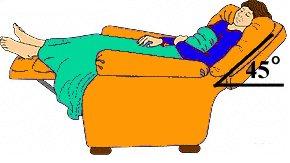
Now I know that many of you happily live your lives, in a care free and relaxed manner, without ever giving a thought to the dangers that lurk in every corner of your existence.
However, don't panic, Nanny spends the most part of her life worrying about these dangers on our behalf.
Thank you Nanny!
Indeed she has recently identified another, previously considered "harmless", activity that urgently needs the "Nanny treatment".
Sitting in reclining chairs, it seems, is very dangerous.
Therefore Nanny's chums in the Greater Manchester Fire Service have drawn up a four-page safety manual to instruct crews on how to sit in a reclining chair.
Firemen, you might recall, are those brave ladies and gentlemen who risk life and limb on our behalf putting out fires and rescuing people from burning buildings.
You would have thought that they had a healthy appreciation of risk; Nanny thinks otherwise.
Those firemen from Manchester hoping for a rest between call-outs are banned from doing so, until they have been trained to use the fireservice's new £400 reclining chair.
This may take some time, however, since Greater Manchester Fire Service employs 2,200 personnel in 41 stations.
The instructions for sitting down are as follows:
Take out their "personal-issue head protector", and place it on the back of the chair.
Then, and only then, can they begin their descent, a process that must end with them sitting "fully back". Those that get this far can "get ready to recline".
The manual then advises:
"To release the mechanism (i.e. to start reclining), simply lift the lever under the right-hand arm of the chair (when seated).
This moves the chair into its semi-reclined position (i.e. feet up, head up)."
To recline the chair fully, they must hold on to the arm rests and push backwards.
To "upright" [sic] the chair, the occupant "should sit up slightly into the semi-reclined position, hold on to the armrest then press downwards with their heels until the action locks the chair flush".
Crews are warned that only "trained personnel" can carry out "lubrication of mechanisms", and that sleeping bags must not be used.
They are also given advice on how to deal with spillages - "tissue should firstly be placed on the stain to absorb excess liquid" - and warned that horseplay involving recliners is deemed a disciplinary offence.
The fire service has spent £130,000 on new Calcot recliners, which will be used as beds during night shifts.
A fire service spokesman said:
"Training will be given for health and safety reasons.
There are moving parts."
I sit on a swivel chair when working, which I constructed myself; am I in danger?

We're going to be in real trouble once the HSE figure out fire and smoke are a bit on the hazardous side......
ReplyDeleterailwayman39's observation reminds me of a tale told by an acquaintance who was in the RAF (Regiment I think - read on).
ReplyDeleteOne of his postings involved repsonsibilities for dealing with unexploded bombs and the like and a in a close working relationship with the Army they used tanks and armoured vehicles.
To access (or egress) a tank quickly the various crew members often have individual hatches. To reach the hatches you have to climb on the tank. If you arer outside the tank and someting dodgy kicks off you want to be inside it as quickly as possible, more often than not (unless there is US fighter bomber with 60 miles or course!)
On an exercise one day they were being observed by someone with a health and safety brief. Person was horrified as the crew clamboured onto the tank in order to gain access and strongly proposed that they should be using ladders ... so the HSE must be quite keen on ladders, provided proper training is given.
When questioned about how they should retrieve the ladders under fire and where to store them for protection yet ease of access and use should the vehicle be hit by 'something explosive' no matter what the source, the H&S person seemed to struggle to find a useful answer.
Surprising really ...
I rather suspect that someone has done a great selling job to shift the recliners for use as bed substitutes on a regular basis in an industrial environment. We could run a book on how long they will last between rebuilds or replacement.
got to agree with Grant's last comment, I do wonder what sort of warranty these seats came with. or being as how it's our money being spent for us probably a nice little service contract.
ReplyDeleteAs for the training this is all part of the great compensation culture con. If staff are trained in the proper use of equipment it reduces their ability to sue when for example a delicate fire person hurts their back because the chair refuse to recline for them.
As for using chairs for beds, didn't think that was recommended in the long term anyway.
The warranty angle is a good point from Chris.
ReplyDeleteIf the supplier has not pinned this one down they could be on and endless replacement cycle a few months into the contract which may not do them any good at all.
If they have pinned it down the repair and replacement costs will come from the public one way or another.
Perhaps the change in working practices which has encouraged this decision manes that the chairs will be little used for any purpose?
In which case they might be viable financially if the bed space saved really can be put to alternative worthwhile use.
Will we ever know?
You might not beleive this but it is true. The Calcot "Chair" is not designed to be sat in. You can only use it to rest in.
ReplyDelete